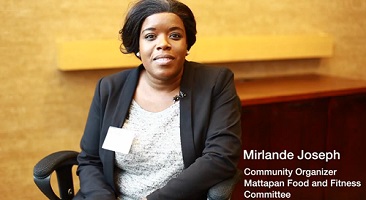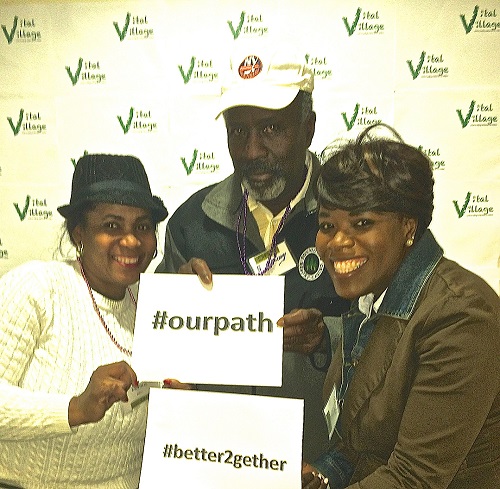Community Engagement in Real Time: What I Learned from Woolson Street

Mirlande Joseph is a Community Organizer for the Mattapan Food and Fitness Coalition (MFFC). In this role, Mirlande worked with MFFC to engage residents in planning and opening the Woolson St. Community Garden this past fall. Following the leadership summit, Mirlande set her 90-day challenge aim on building a neighborhood association in the Woolson Street neighborhood. AmeriCorps VISTA member, Meghna Nandi, reflects on her work around community mobilization and her process of learning what community engagement looks like in real life – in “real time”: Through Mirlande’s emphasis on building strong relationships and listening to stories, she realized that community engagement is not about having a set “one-size fits all” roadmap, but about constructing the circumstances that empower residents to draw their own roadmap.
When I first started working at Vital Village, I was inspired by the amazing community engagement work fostered by our partners’ various collaborative and innovative efforts. At the same time, my head began to spin with questions. What does community engagement actually look like in “real-time?” What makes some community engagement efforts prevail and others fall? What conditions and resources are needed to foster community engagement? Since my job at Vital Village network entails being a “community mobilization coordinator,” trust me, I was anxious to get some answers.
Luckily for me, I began to find answers to some of these questions by partnering with Mirlande Joseph and supporting her 90-Day Challenge aim to build a neighborhood association on Woolson St. Mirlande Joseph is a Community Organizer for the Mattapan Food and Fitness Coalition (MFFC). Mirlande worked with MFFC to engage community residents in the design and opening of the Woolson St. Community Garden this past fall. She wanted to continue to build on this momentum and following the leadership summit Mirlande set her 90-day challenge aim to sustain resident engagement on Woolson Street by bringing this neighborhood association to life.

Setting an Aim

One of Mirlande’s first steps toward her goal of establishing a neighborhood association was attending Vital Village’s Leadership Summit last October. The skills around goal setting and decision-making and the networking opportunities that the leadership summit presented allowed Mirlande to jumpstart this work. Mirlande recounts how she felt seeing other Vital Village partners who were working toward their own goals and meeting individuals who could collaborate with her: “I didn’t feel like I was just one person in a challenge – I had people behind me.” The summit also provided her with tools to tackle her vision by breaking it down into smaller goals.
One of the first goals Mirlande set after the summit was holding a focus group to bring together residents around Woolson St. who were interested in talking about issues in their community. First and foremost, this meeting’s goal was to start building relationships with and among the residents and to provide a space where residents could speak freely about their own needs and desires for their community’s future. Mirlande fondly remembers the high she felt after seeing the turnout and level of participation from the residents: “It was a great feeling. It made me feel like they do really care about their community!”
Improvement Cycles and Authentic Shared Decision-Making
In the following months, we held two more meetings and utilized improvement cycles from the Leadership Summit; we modified the structure and activities planned for a meeting based on the feedback and outcomes from the previous meeting. Yes, this counts as a test of change, and an improvement. We often do not consider testing and change on such a small scale, but the fact is testing on this level to make incremental improvements can make a huge impact on the quality of work we do in the long run.
Although Mirlande and I facilitated the discussions, in all three of these meetings, the residents themselves made determined the identified needs, visions, and goals for the group. As facilitators, our role was to create a safe space where residents had the opportunity to voice their concerns and unite in their desires and efforts to better their community. Our job was to foster conditions that could encourage residents to engage in community issues that they themselves identify as relevant and significant to their own lives. We enabled residents voices to be heard by using activities that encouraged residents to brainstorm creatively, providing residents with ample time to reflect, and encouraging every community member present to contribute their ideas and share them with the larger group. We also conducted the meeting in both English and Haitian-Creole to address a language barrier that often prevents some of these residents’ voices from being heard. These subtle, yet significant elements we incorporated all together created a unique space for residents – a space that told residents their voices mattered, their needs should be a priority, and their hopes could become a reality.

Over the course of three meetings, I saw how such an environment brought community members out of their shell. I observed their enthusiasm elevate as they were able to speak openly about their vision for the future of their community. I felt their commitment to their cause grow as they continued coming to the meetings in spite of long days, freezing cold nights, and bouts of snow. I watched Mirlande invest time listening to the residents’ stories and validating their ideas. I witnessed residents, in turn, begin to rally more and more around Mirlande and her ultimate goal of establishing the resident association.
In short, I got a glimpse of what “community engagement” looks like in real life – in “real time.” Through Mirlande’s emphasis on building strong relationships and listening to stories, I realized that community engagement is not about having a set “one-size fits all” roadmap, but about constructing the circumstances that empower residents to draw their own roadmap.

